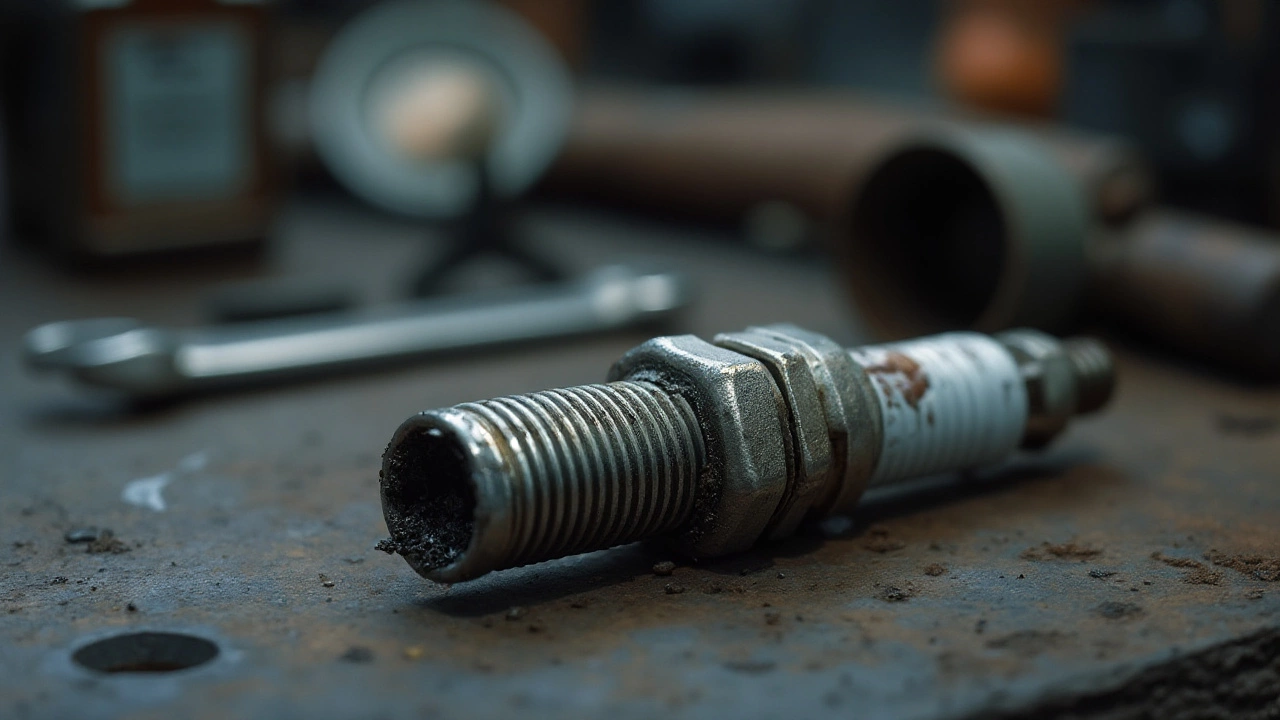Many car owners often wonder about the secret to a smooth, uninterrupted engine idle. One key component often overlooked is the humble spark plug. These small, yet essential parts play a pivotal role in engine performance, including idle quality.
Spark plugs are responsible for igniting the air-fuel mixture in the engine's cylinders. As time passes, these plugs can wear down, leading to rough idling, decreased mileage, and even engine misfires. Regularly checking and replacing spark plugs can restore your engine's idle and performance.
In this article, we'll delve into the world of spark plugs, exploring their key functions, signs they're failing, and how changing them can dramatically improve your engine's idle. Whether you're a seasoned car enthusiast or just beginning your automotive journey, understanding spark plugs is imperative for keeping your car running smoothly.
- Understanding Spark Plugs and Their Role
- Signs of Deteriorating Spark Plugs
- Why a Smoother Idle Matters
- Steps for Replacing Spark Plugs
- Tips for Maintaining Spark Plug Health
Understanding Spark Plugs and Their Role
For those who are not entirely familiar with the inner workings of an engine, the role of spark plugs might seem small, but its impact is undeniably immense. At its core, a spark plug is responsible for providing the spark that ignites the air-fuel mixture in the engine's combustion chambers. This ignition is what sets the pistons in motion, eventually powering the vehicle. Simply put, without functioning spark plugs, an engine cannot run efficiently, if at all.
Every ignition stroke in the engine relies on this tiny device to combust the fuel efficiently. Each plug has a durable construction, typically featuring a central electrode and a ground electrode separated by a gap. When adequately charged, they generate a spark that bridges this gap, igniting the mixture within the cylinder. In modern vehicles, spark plugs are designed to last between 20,000 and 100,000 miles, depending on the material used in their construction, which could include copper, platinum, or even iridium.
"Spark plugs are critical for any engine's efficiency. A minor wear and tear can considerably affect performance," notes renowned automotive engineer Dr. Harold Simmons.What many vehicle owners might find surprising is that different engines may require specific types of plugs to perform optimally. Standard copper plugs, for instance, are great for older vehicles, while iridium plugs provide longevity ideal for modern engines with advanced ignition systems. The intricacies of spark plug technology might be akin to alchemy, but understanding just a little about their function can help immensely in appreciating their importance.
Recent advances have further emphasized the need for modern vehicles to maintain the correct gap between electrodes to ensure optimal performance. Misfires, poor fuel economy, and sluggish performance might suggest that spark plugs are overdue for a check-up. Knowing this, automotive designers and manufacturers continuously innovate, creating plugs that withstand the harsh conditions of an engine's interior. It's no overstatement to say that these small components are the unsung heroes of every gasoline-powered vehicle's engine.
Maintaining a vehicle's engine involves ensuring that spark plugs are in good condition. Regularly inspecting them helps in analyzing how the engine runs, often revealing if the vehicle is running rich or lean—that is, if the air-fuel mixture is overly heavy or light on fuel. In fact, these small clues play a massive role in diagnosing and preventing potential engine issues. Thus, comprehending the role of spark plugs is pivotal for anyone who seeks the best for their car.
Signs of Deteriorating Spark Plugs
One might not immediately suspect spark plugs as the culprit behind a sputtering engine, but these small components hold great responsibility. When spark plugs begin to deteriorate, the signs can manifest in various ways, causing engine systems to work harder and less efficiently. Often, a vehicle's idle is one of the first performance aspects affected. A key indicator is a rough or erratic idle, where the engine may feel as though it is vibrating or shuddering. This occurs because worn spark plugs misfire, causing combustion inconsistencies within the engine cylinders. These misfires can be infrequent or repetitive, creating the impression of an unsettled engine health.
In addition to a rough idle, declining spark plugs can lead to difficulty starting the engine. Imagine turning the key in the ignition on a chilly morning, only to experience sluggish turnover or repeated attempts to get your vehicle running. This often indicates that the spark plugs' ability to ignite the air-fuel mixture efficiently has been compromised. It's also common for declining plugs to trigger poor fuel economy. As spark efficiency wanes, the engine compensates by consuming more fuel, which might be noticeable in dwindling MPG figures. This performance drop-off is accompanied by increased emissions—bad news for both your car and the environment.
Check engine lights can also be a signal that your spark plugs need attention. Modern engines are equipped with various sensors that monitor performance, and a check engine light is a beacon notifying you of irregularities. If you're a fan of diagnostics, a scan tool can often reveal misfire codes related specifically to spark plug troubles. Pay close attention to engine surges or hesitations as well, where despite having a steady foot on the accelerator, the car seems to unpredictably speed up or lose power for no clear reason. These instances further exemplify disrupted combustion processes.
"Routine checks and timely replacements of spark plugs are crucial for maintaining the harmony between smooth idle and overall engine performance," advises automotive expert Jeremy Applegate in his journal article on engine maintenance. "Continued operation with outdated plugs can amplify wear across multiple engine components."
Visual inspections of spark plugs can reveal much to a discerning eye. Look for wear such as rounded edges on the center electrode or deposits indicating oil-fouling. Furthermore, healthy spark plugs typically exhibit a lightly browned ceramic insulator, similar to toast, whereas black soot could point to an engine running too rich. If you notice any signs of cracking or blistering on the plug body, it's time for replacements. Regularly inspecting and replacing worn plugs not only restores engine performance but assures longevity and reliability of your vehicle's vital parts.

Why a Smoother Idle Matters
A smooth engine idle is much more than a sign of a well-tuned machine; it's the telltale heart of your car's overall health. When your vehicle runs smoothly, you're more likely to notice better fuel efficiency and less stress on your car's internal parts. A rough or inconsistent idle, however, can signal underlying issues that might lead to costly repairs if ignored for too long. Addressing these initial signs by maintaining clean and efficient spark plugs can prevent escalating problems.
A smoothly idling engine operates more quietly, which adds to your comfort and driving experience. Imagine sitting at a red light and feeling the rhythmic, almost purring hum of your engine, indicating that all components are working in harmony. Such an experience is both reassuring and calming, much like a silent promise of reliability every time you drive. When an engine idles without hiccups, it's analogous to a well-rehearsed orchestra performing in perfect synchrony.
Beyond personal comfort, there's a technological and environmental aspect to consider. A good idle means that your vehicle is minimizing its emissions. The cleaner the combustion process, the fewer pollutants are released into the atmosphere. This means that maintaining new, functional spark plugs not only aids in your car's performance but also contributes to a cleaner environment. Think of it as doing your small part in helping reduce the carbon footprint of your daily commute.
Economic Implications of Smooth Idling
When we talk about economics, we aren’t just referring to fuel savings, although they are substantial. Think about the implications of a poorly idling engine on your wallet. Ignoring a rough idle today may lead to prolonged and more severe engine problems tomorrow. These can range from failing oxygen sensors to damaged ignition coils, each representing a potential hefty bill at your mechanic’s. By ensuring those spark plugs are in top shape, you're actively safeguarding against unexpected expenses.
Carmaker Toyota notes, "Regular engine maintenance is crucial not only for vehicle performance but also in avoiding higher repair costs down the line."
Moreover, there's the advantage of resale value. A well-maintained engine symbolized by a soothing idle reassures potential buyers of the vehicle’s upkeep. That's something I like to pitch as pocket value: your investment when it comes to selling your used car or trading it in for a new ride. Years down the line, that consistent attention to the tiny details like spark plugs could mean much more dollars retained in your pocket.
Steps for Replacing Spark Plugs
Replacing spark plugs is a task many DIY enthusiasts can accomplish with confidence. Before rolling up your sleeves, gather all necessary tools and ensure your engine is cool to avoid burns. Begin by locating the spark plugs, typically found along the engine block's cylinder head. Taking note of their exact positioning will help during reinstallation. Remove any decorative engine covers that might obstruct access, carefully noting their attachment locations. This simple preparatory step ensures you start on the right foot and avoid common pitfalls.
Once you've gained access, identify the spark plug wire or coil pack for each cylinder. These are critical links in your engine's ignition system, and tugging them recklessly can cause damage. Using a gentle twisting motion, disconnect these wires to avoid tearing them. With the wires safely out of the way, proceed to unscrew the spark plugs using a ratchet and spark plug socket. Maintain a steady hand to ensure the plugs come out clean without breaking inside the cylinder. This step is crucial to avoid time-consuming extractions and costly repairs.
Before installing new plugs, inspect them for any shipping defects. Each new spark plug has distinct inscriptions indicating the appropriate gap size, which is crucial for optimal engine performance. Employ a gap tool to adjust this spacing, if necessary, ensuring precise ignition timing. Improperly gapped spark plugs could lead to misfires and a rough engine idle, underscoring the importance of this detail.
"An engine is the heart of a vehicle, and spark plugs are the vital sparks of life," says automotive expert Ron Miller.
With your spark plugs properly prepped, gently thread each one into the engine by hand to avoid cross-threading — a potential headache for aspiring mechanics. Follow up with your ratchet, securing them snugly without overtightening to prevent fracturing. Then reattach the spark plug wires or coil packs with a satisfying click, confirming a secure connection. This ensures effective power transmission from the ignition system.
Finally, reassemble any parts previously removed and perform a test run. Listen to your engine's revs, feeling for that sought-after smooth idle. Successfully replacing your spark plugs can bring immediate rewards, such as improved fuel economy and engine performance. The process, while methodical, equips you with the know-how to maintain your vehicle in prime condition.

Tips for Maintaining Spark Plug Health
Keeping your spark plugs in top-notch condition is essential for ensuring your engine idle stays sweet and steady. These plugs may be small, but they play a huge role in engine performance and efficiency. To preserve their health, one needs to pay attention to routine maintenance and subtle changes in vehicle behavior. Regular checks should become a part of your car maintenance ritual as they can highlight the slightest deviation from normalcy. Clean and healthy spark plugs lead to more efficient burning of the air-fuel mixture, translating into smoother idling and better fuel economy. As part of the maintenance, you should inspect your plugs at least every 30,000 miles or as recommended by your car's manufacturer. Spark plug checks can be likened to a doctor's routine checkup for preventive measures. Always have a set of basic tools handy so you can nip potential issues in the bud before they morph into costly repairs.
Checking the condition of your engine’s spark plugs can be a telling diagnostic tool. It can reveal more than just the health of the plug itself. When you remove the plug, examine its color. A light tan or grey-colored plug generally signals a healthy engine condition, whereas a plug covered in oil suggests a problematic engine that might need further investigation. If you notice frequent engine misfires or difficulty starting your vehicle, it might be time to replace those plugs. Remember, maintaining spark plugs isn’t just about replacing them at the first sign of trouble, but understanding the story they tell about your engine.
Proper installation is another crucial aspect of maintaining spark plug health. Always follow the manufacturer’s torque specifications when installing new plugs. An improperly tightened plug could lead to compression loss or even damage the cylinder head. Modern cars use platinum or iridium spark plugs for enhanced durability and performance, lasting up to 100,000 miles under optimal conditions. Experts suggest that using the right type of plug specifically recommended for your car can maximize both performance and longevity. According to Bob Weber, an expert in automotive care, “Investing a little more now for top-quality plugs can pay off greatly in terms of performance and fuel efficiency.”
One essential trick to keep those plugs in pristine condition involves using high-quality fuel. The importance of clean fuel cannot be understated as it prevents harmful deposits from forming on the spark plugs. Consider using fuel additives occasionally to clean the combustion chamber and keep things running smoothly. Pay attention to engine oil, as old or poor-quality oil can also clog your plugs, harm engine health, and reduce idle quality.
| Type of Spark Plug | Average Lifespan (miles) |
|---|---|
| Copper | 10,000 - 20,000 |
| Platinum | 60,000 - 100,000 |
| Iridium | 80,000 - 120,000 |

